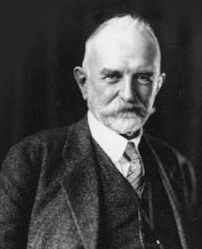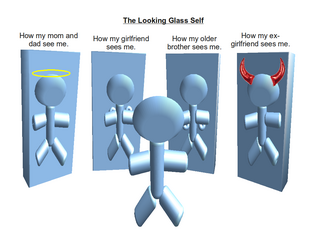
In sociology, socialization is the process of internalizing the norms and ideologies of society. Socialization encompasses both learning and teaching and is thus "the means by which social and cultural continuity are attained".
A role is a set of connected behaviors, rights, obligations, beliefs, and norms as conceptualized by people in a social situation. It is an expected or free or continuously changing behavior and may have a given individual social status or social position. It is vital to both functionalist and interactionist understandings of society. Social role theory posits the following about social behavior:
- The division of labour in society takes the form of the interaction among heterogeneous specialized positions, we call roles.
- Social roles included appropriate and permitted forms of behavior and actions that recur in a group, guided by social norms, which are commonly known and hence determine the expectations for appropriate behavior in these roles, which further explains the position of a person in the society.
- Roles are occupied by individuals, who are called actors.
- When individuals approve of a social role, they will incur costs to conform to role norms, and will also incur costs to punish those who violate role norms.
- Changed conditions can render a social role outdated or illegitimate, in which case social pressures are likely to lead to role change.
- The anticipation of rewards and punishments, as well as the satisfaction of behaving pro-socially, account for why agents conform to role requirements.

Symbolic interactionism is a sociological theory that develops from practical considerations and alludes to humans' particular use of shared language to create common symbols and meanings, for use in both intra- and interpersonal communication. According to Macionis, symbolic interactionism is "a framework for building theory that sees society as the product of everyday interactions of individuals". In other words, it is a frame of reference to better understand how individuals interact with one another to create symbolic worlds, and in return, how these worlds shape individual behaviors. It is a framework that helps understand how society is preserved and created through repeated interactions between individuals. The interpretation process that occurs between interactions helps create and recreate meaning. It is the shared understanding and interpretations of meaning that affect the interaction between individuals. Individuals act on the premise of a shared understanding of meaning within their social context. Thus, interaction and behavior is framed through the shared meaning that objects and concepts have attached to them. From this view, people live in both natural and symbolic environments.

George Herbert Mead was an American philosopher, sociologist, and psychologist, primarily affiliated with the University of Chicago. He was one of the key figures in the development of pragmatism. He is regarded as one of the founders of symbolic interactionism, and was an important influence on what has come to be referred to as the Chicago School of Sociology.

In micro-sociology, interactionism is a theoretical perspective that sees social behavior as an interactive product of the individual and the situation. In other words, it derives social processes from social interaction, whereby subjectively held meanings are integral to explaining or understanding social behavior.

Charles Horton Cooley was an American sociologist. He was the son of Michigan Supreme Court Judge Thomas M. Cooley. He studied and went on to teach economics and sociology at the University of Michigan. He was a founding member of the American Sociological Association in 1905 and became its eighth president in 1918. He is perhaps best known for his concept of the looking-glass self, which is the concept that a person's self grows out of society's interpersonal interactions and the perceptions of others. Cooley's health began to deteriorate in 1928. He was diagnosed with an unidentified form of cancer in March 1929 and died two months later.
The generalized other is a concept introduced by George Herbert Mead into the social sciences, and used especially in the field of symbolic interactionism. It is the general notion that a person has of the common expectations that others may have about actions and thoughts within a particular society, and thus serves to clarify their relation to the other as a representative member of a shared social system.

Labeling theory posits that self-identity and the behavior of individuals may be determined or influenced by the terms used to describe or classify them. It is associated with the concepts of self-fulfilling prophecy and stereotyping. Labeling theory holds that deviance is not inherent in an act, but instead focuses on the tendency of majorities to negatively label minorities or those seen as deviant from standard cultural norms. The theory was prominent during the 1960s and 1970s, and some modified versions of the theory have developed and are still currently popular. Stigma is defined as a powerfully negative label that changes a person's self-concept and social identity.
Herbert George Blumer was an American sociologist whose main scholarly interests were symbolic interactionism and methods of social research. Believing that individuals create social reality through collective and individual action, he was an avid interpreter and proponent of George Herbert Mead's social psychology, which he labeled symbolic interactionism. Blumer elaborated and developed this line of thought in a series of articles, many of which were brought together in the book Symbolic Interactionism. An ongoing theme throughout his work, he argued that the creation of social reality is a continuous process. Blumer was also a vociferous critic of positivistic methodological ideas in sociology.
The 'I' and the 'me' are terms central to the social philosophy of George Herbert Mead, one of the key influences on the development of the branch of sociology called symbolic interactionism. The terms refer to the psychology of the individual, where in Mead's understanding, the "me" is the socialized aspect of the person, and the "I" is the active aspect of the person.
A label is an abstract concept in sociology used to group people together based on perceived or held identity. Labels are a mode of identifying social groups. Labels can create a sense of community within groups, but they can also cause harm when used to separate individuals and groups from mainstream society. Individuals may choose a label, or they may be assigned one by others. The act of labeling may affect an individual's behavior and their reactions to the social world.

The term looking-glass self was created by American sociologist Charles Horton Cooley in 1902, and introduced into his work Human Nature and the Social Order. It is described as our reflection of how we think we appear to others. Cooley takes into account three steps when using "the looking glass self". Step one is how one imagines one looks to other people. Step two is how one imagines the judgment of others based on how one thinks they view them. Step three is how one thinks of how the person views them based on their previous judgments.

In sociology, social psychology studies the relationship between the individual and society. Although studying many of the same substantive topics as its counterpart in the field of psychology, sociological social psychology places relatively more emphasis on the influence of social structure and culture on individual outcomes, such as personality, behavior, and one's position in social hierarchies. Researchers broadly focus on higher levels of analysis, directing attention mainly to groups and the arrangement of relationships among people. This subfield of sociology is broadly recognized as having three major perspectives: Symbolic interactionism, social structure and personality, and structural social psychology.

Collective mental state is generally a literary or legal term, mostly used in sociology and philosophy, to refer to the condition of someone's being-state when around others. An assessment of a collective mental state includes a description of thought processes, memory, emotions, mood, cognitive state, and energy levels, including the meta overlay of interactions between individuals.
In sociology, a significant symbol is a gesture that calls out in the individual making the gesture the same response that is called out in others to whom the gesture is directed. Significant symbols are a later by-product of the meaning emergent in the act, which meaning is described, or accounted for, in terms of symbols or language.
Media studies encompasses the academic investigation of the mass media from perspectives such as sociology, psychology, history, semiotics, and critical discourse analysis. The purpose of media studies is to determine how media affects society.

The sociology of human consciousness or the sociology of consciousness uses the theories and methodology of sociology to explore and examine consciousness.
Lonnie Athens teaches in the criminology department at Seton Hall University and was senior research criminologist at Georgetown University Law Center.
In sociology and other social sciences, internalization means an individual's acceptance of a set of norms and values through socialisation.
Primary socialization in sociology is the period early in a person's life during which they initially learn and develop themselves through experiences and interactions. This process starts at home through the family, in which one learns what is or is not accepted in society, social norms, and cultural practices that eventually one is likely to take up. Primary socialization through the family teaches children how to bond, create relationships, and understand important concepts including love, trust, and togetherness. Agents of primary socialization include institutions such as the family, childhood friends, the educational system, and social media. All these agents influence the socialization process of a child that they build on for the rest their life. These agents are limited to people who immediately surround a person such as friends and family—but other agents, such as social media and the educational system have a big influence on people as well. The media is an influential agent of socialization because it can provide vast amounts of knowledge about different cultures and society. It is through these processes that children learn how to behave in public versus at home, and eventually learn how they should behave as people under different circumstances; this is known as secondary socialization. A vast variety of people have contributed to the theory of primary socialization, of those include Sigmund Freud, George Herbert Mead, Charles Cooley, Jean Piaget and Talcott Parsons. However, Parsons' theories are the earliest and most significant contributions to socialization and cognitive development.







